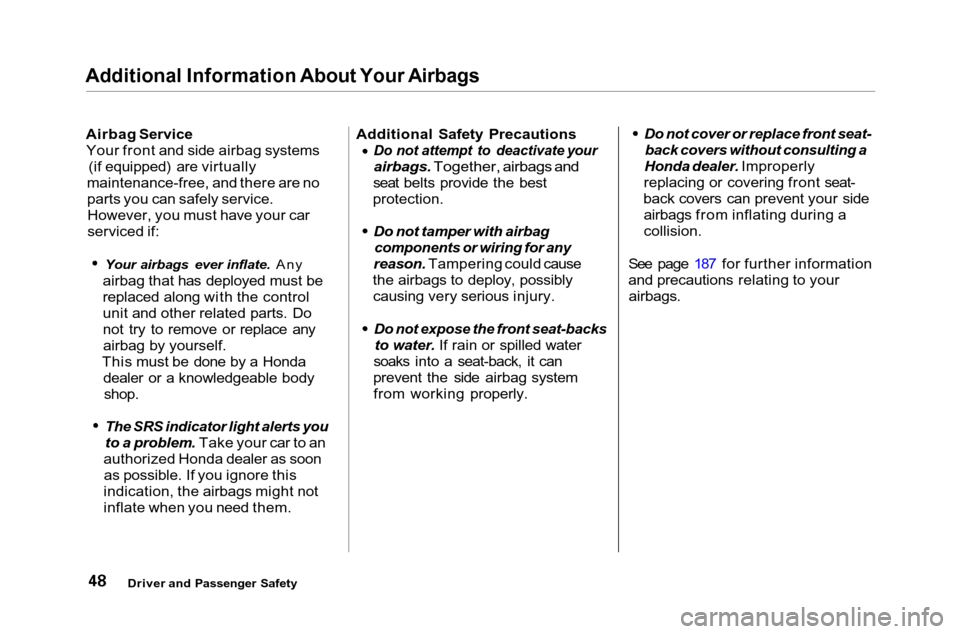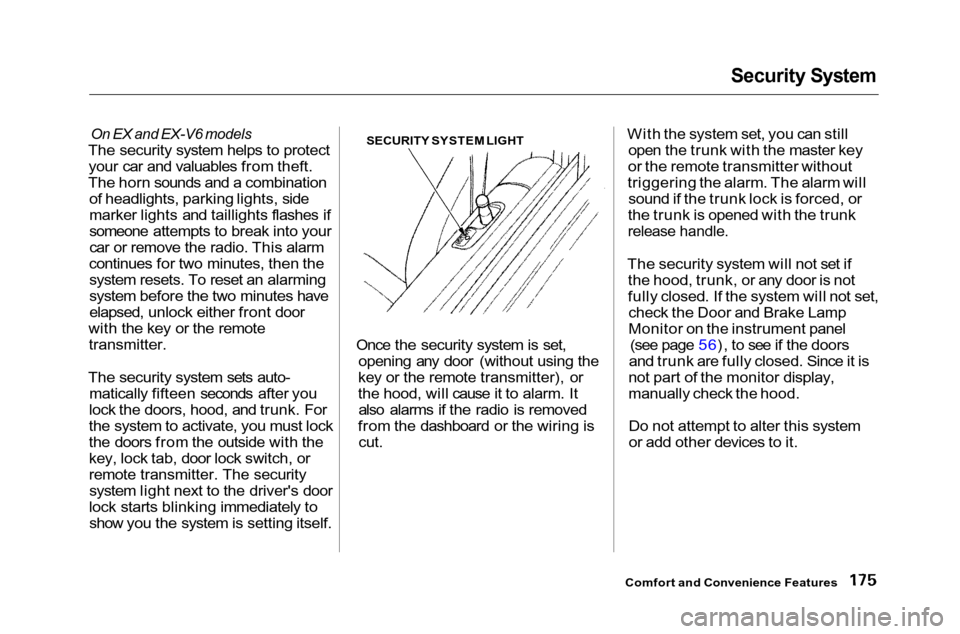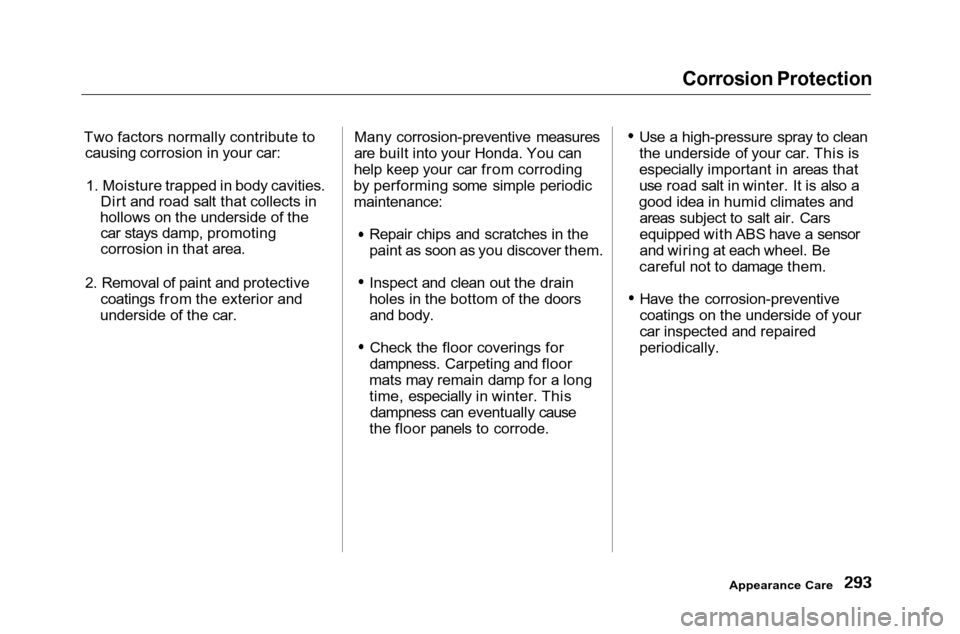wiring HONDA ACCORD COUPE 2001 CF / 6.G Owners Manual
[x] Cancel search | Manufacturer: HONDA, Model Year: 2001, Model line: ACCORD COUPE, Model: HONDA ACCORD COUPE 2001 CF / 6.GPages: 372, PDF Size: 6.1 MB
Page 51 of 372

Additional Information About Your Airbags
Airbag ServiceYour front and side airbag systems (if equipped) are virtually
maintenance-free, and there are no
parts you can safely service. However, you must have your car
serviced if:
Your airbags ever inflate. Any
airbag that has deployed must be
replaced along with the control
unit and other related parts. Do
not try to remove or replace any airbag by yourself.
This must be done by a Honda dealer or a knowledgeable body
shop.
The SRS indicator light alerts you
to a problem. Take your car to an
authorized Honda dealer as soon as possible. If you ignore this
indication, the airbags might not
inflate when you need them. Additional Safety Precautions
Do not attempt to deactivate your
airbags. Together, airbags and
seat belts provide the best
protection.
Do not tamper with airbag
components or wiring for any
reason. Tampering could cause
the airbags to deploy, possibly causing very serious injury.
Do not expose the front seat-backs
to water. If rain or spilled water
soaks into a seat-back, it can
prevent the side airbag system from working properly.
Do not cover or replace front seat-
back covers without consulting a
Honda dealer. Improperly
replacing or covering front seat-
back covers can prevent your side airbags from inflating during a
collision.
See page 187 for further information
and precautions relating to your
airbags.
Driver and Passenger Safety
Page 178 of 372

Security System
On EX and EX-V6 models
The security system helps to protect your car and valuables from theft.
The horn sounds and a combination of headlights, parking lights, side
marker lights and taillights flashes if
someone attempts to break into your
car or remove the radio. This alarm
continues for two minutes, then the system resets. To reset an alarming
system before the two minutes have
elapsed, unlock either front door
with the key or the remote transmitter.
The security system sets auto- matically fifteen seconds after you
lock the doors, hood, and trunk. For
the system to activate, you must lock
the doors from the outside with the
key, lock tab, door lock switch, or
remote transmitter. The security system light next to the driver's door
lock starts blinking immediately to show you the system is setting itself. SECURITY SYSTEM LIGHT
Once the security system is set, opening any door (without using the
key or the remote transmitter), or
the hood, will cause it to alarm. It also alarms if the radio is removed
from the dashboard or the wiring is cut. With the system set, you can still
open the trunk with the master key
or the remote transmitter without
triggering the alarm. The alarm will sound if the trunk lock is forced, or
the trunk is opened with the trunk
release handle.
The security system will not set if the hood, trunk, or any door is not
fully closed. If the system will not set,check the Door and Brake Lamp
Monitor on the instrument panel (see page 56), to see if the doors
and trunk are fully closed. Since it is
not part of the monitor display,
manually check the hood.
Do not attempt to alter this system
or add other devices to it.
Comfort and Convenience Features
Page 217 of 372

Towing a Trailer
Trailer Lights
Your vehicle has a trailer lighting connector in the trunk. Refer to thedrawing in this page for the wiring
color code and purpose of each pin.
If you use a converter, you can get
the connector and pins that mate
with the connector in your vehicle from your Honda dealer.
Since lighting and wiring vary in
trailer type and brand, you should also have a qualified mechanic install
a suitable connector between the
vehicle and the trailer.
Driving GROUND
(BLACK)
BACK-UP LIGHT
(GREEN/BLACK) LEFT TURN SIGNAL
(GREEN/BLUE)
TAILLIGHT(RED/BLACK)
BRAKE LIGHT
(WHITE/BLACK)
RIGHT TURN SIGNAL
(GREEN/YELLOW)
Page 296 of 372

Corrosion Protection
Two factors normally contribute to causing corrosion in your car:
1. Moisture trapped in body cavities. Dirt and road salt that collects in
hollows on the underside of the car stays damp, promoting
corrosion in that area.
2. Removal of paint and protective coatings from the exterior and
underside of the car. Many corrosion-preventive measures
are built into your Honda. You can
help keep your car from corroding
by performing some simple periodic maintenance:
Repair chips and scratches in the
paint as soon as you discover them.
Inspect and clean out the drain
holes in the bottom of the doorsand body.
Check the floor coverings for
dampness. Carpeting and floor
mats may remain damp for a long
time, especially in winter. This dampness can eventually cause
the floor panels to corrode. Use a high-pressure spray to clean
the underside of your car. This is
especially important in areas that
use road salt in winter. It is also a
good idea in humid climates and areas subject to salt air. Cars
equipped with ABS have a sensor
and wiring at each wheel. Be
careful not to damage them.
Have the corrosion-preventive
coatings on the underside of your
car inspected and repaired
periodically.
Appearance Care